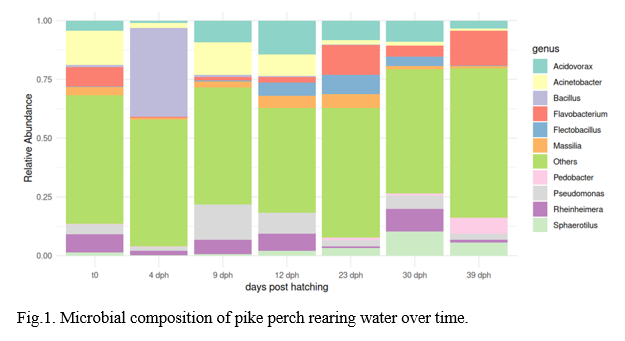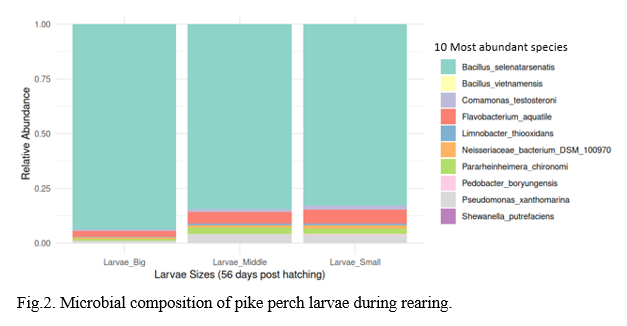DEVELOPMENT OF A MICROBIOME-BASED EARLY DETECTION SYSTEM FOR STANDARDISED QUALITY ASSESSMENT IN PIKEPERCH Sander lucioperca LARVAE
Introduction
The rearing of new aquaculture-relevant species often faces challenges due to limited knowledge about nutritional requirements and other key parameters, frequently resulting in morphological deformities in embryos and larvae. Among the major bottlenecks in the successful cultivation of pikeperch is the low survival rate of larvae, which is often accompanied by a high incidence of malformations (Policar et al.2019; Colcen et al.2020). One of the suspected contributors to these deformities is the microbial environment, particularly the presence of pathogenic or toxin-producing bacteria. Stress sensitivity during critical development phases—especially during the transition to dry feed—can further exacerbate the impact of bacterial pathogens which may lead to the growth of harmful bacteria that produce toxins capable of inducing developmental abnormalities. To better understand and prevent such deformities, continuous monitoring of microbial community composition in the rearing water is essential. A simplified and largely automated system for detecting and quantifying microbial contamination—especially focusing on toxin-producing bacteria—would represent a valuable tool for hatcheries. It would support timely interventions, reduce economic losses, and contribute to higher larval quality and survival. Therefore, the aim of the study was to analyse and quantify specific pathogenic bacteria within the microbial community in the rearing water of pikeperch (Sander lucioperca) larvae. Key bacterial species were identified using qPCR and molecular biology techniques, and corresponding marker genes were developed to enable their rapid detection. In addition, the study investigated the relationship between microbial community composition, water quality, and larval deformities during early development stages. The findings contribute to the advancement of sustainable aquaculture practices and support the development of an automated QualiScore system for the early prediction of larval batch quality.
Material and Methods
Water samples were collected from a commercial pikeperch (Sander lucioperca) hatchery throughout the larval rearing phase to monitor microbial dynamics, starting from tank water without larvae (t₀) and continuing through key developmental stages: 4, 9, 12, 23, 30, 39, and 56 days post-hatch (dph), corresponding to major physiological changes such as mouth opening, swim bladder development, transition to dry feed, onset of cannibalism, disease occurrence, and size differentiation. Samples were taken from three different rearing tanks and a biofilter system, with six replicates collected per tank per time point (n = 168). At 56 dph, additional samples (n = 18) were collected from a single tank by separating larvae into small, medium, and large size groups. Bacterial DNA was extracted from 189 samples, and DNA concentration and purity were measured using a Nanodrop spectrophotometer. Microbial community composition was analyzed using 16S rRNA gene amplicon sequencing, and key bacterial taxa were identified. To enable rapid detection of pathogenic and toxin-producing bacterial strains, specific primers for marker genes were developed and quantified using qPCR.
Results and Discussion
Preliminary results showed that microbial analysis of pikeperch larvae revealed shifts in bacterial composition over time and differences by size at 56 dph, highlighting the emergence of Flavobacterium infections at later growth stages. Flavobacterium and Pseudomonas increased in abundance from 12 dph onwards, with early stages showing more diverse profiles. By 23 dph, these genera dominated, likely due to changes in environmental conditions or feeding. The shift towards Flavobacterium suggests a potential risk for emerging infections at later stages of growth.
At 56 dph, larvae grouped by size showed a microbiome dominated by Bacillus species, with smaller larvae having higher levels of harmful genera like Shewanella and Pseudomonas, indicating greater vulnerability to pathogens. However, the high abundances of Pedobacter and Bacillus species suggest a stable microbial community at different developmental stages, which may contribute to disease prevention and better larval health. These findings emphasize the importance of monitoring entire microbial community composition, particularly emerging pathogens like Flavobacterium, to improve larval health and reduce mortality in hatcheries. The presence of beneficial bacteria like Pedobacter and Bacillus may also help prevent diseases in fish.
References
Policar T., Schaefer F.J., Panana E., Meyer S., Teerlinck S., Toner D., Żarski D. (2019). Recent progress in European percid fish culture production technology—tackling bottlenecks. Aquaculture International 27:1151–1174.
Colchen T., Gisbert E., Krauss D., Ledore Y., Pasquet A., P. Fontaine (2020). Improving pikeperch larviculture by combining environmental, feeding and populational factors. Aquaculture Reports 17, 100337.
*This research was supported and funded through Alfred Wegener Institute Helmholtz Center for Polar and Marine Research (AWI) Innovation Found.

